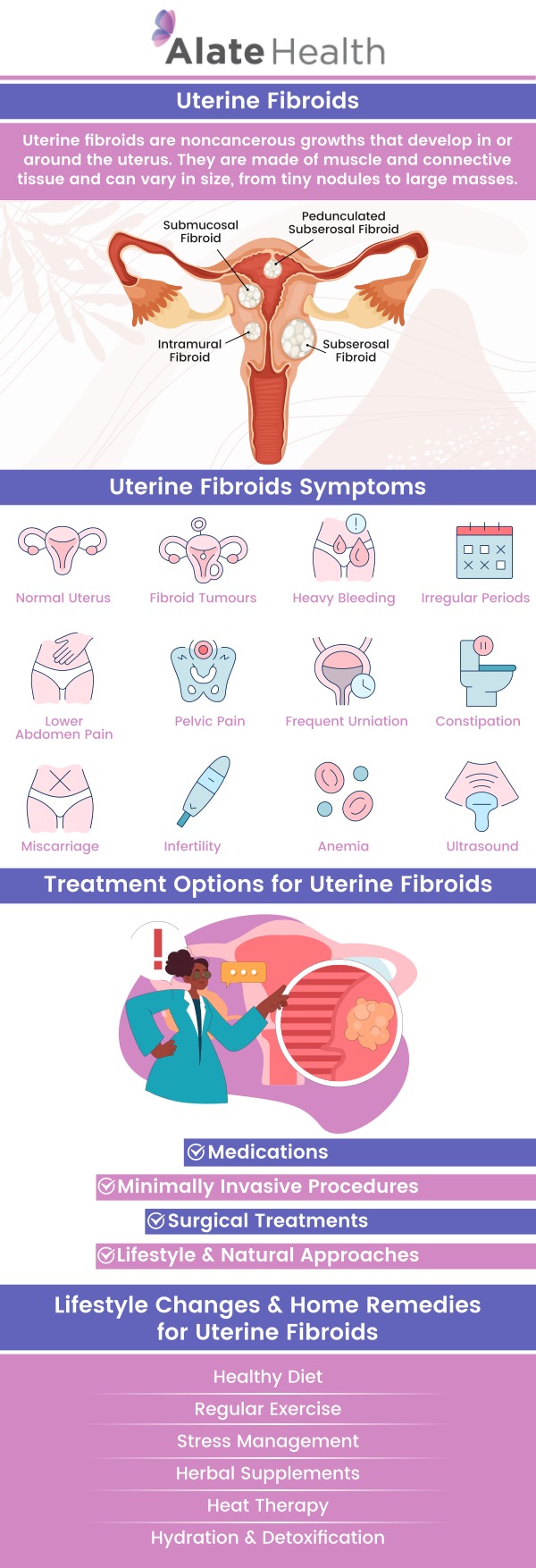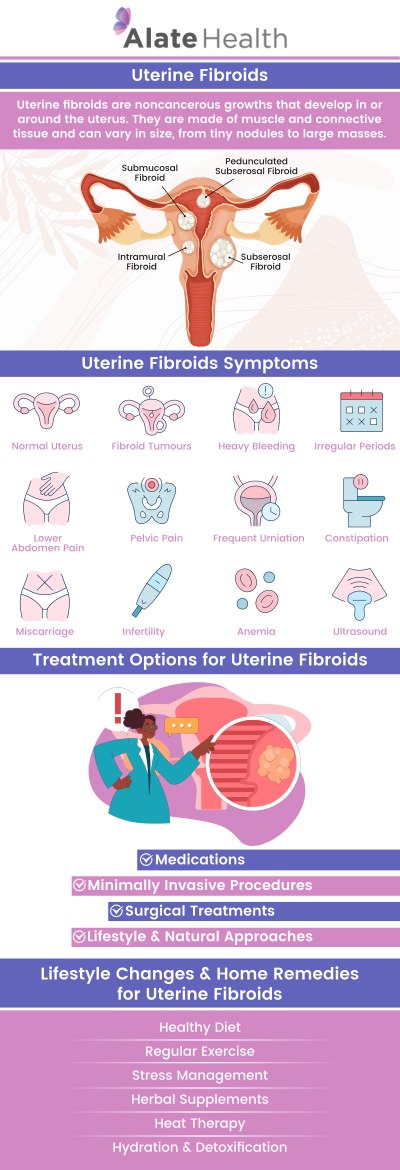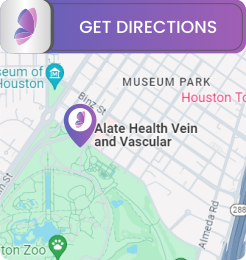Everything You Need to Know About Uterine Fibroid Treatment
Depending on the severity of symptoms and the patient’s individual preferences, several treatment options are available for uterine fibroids. Some women with mild symptoms may choose to observe and wait, as fibroids may shrink or disappear on their own. Others may benefit from medications that can help manage symptoms or reduce the size of the fibroids. For women with more severe symptoms or who desire fertility preservation, surgical interventions may be considered. Andrew Doe, MD at Alate Health Interventional Radiology Clinic, can help patients manage their condition and improve their quality of life. For more details, contact us or book an appointment online. We are conveniently located at 1213 Hermann Dr Suite 255, Houston, TX 77004.




Table of Contents:
What are the types of uterine fibroids?
What factors increase your chance of getting uterine fibroids?
Who is at risk for uterine fibroids?
Can myomectomy remove uterine fibroids?
At Alate Health, we specialize in diagnosing and treating a range of women’s health conditions, including uterine fibroids – noncancerous growths that often appear during childbearing years. Uterine fibroids can vary in size, shape, and number and can be classified based on their specific location in the uterus.
The most common type that we encounter is the intramural fibroid. These growths develop in the muscular wall of the uterus and can expand, causing the uterus to feel larger than normal. Large intramural fibroids can lead to heavy or prolonged menstrual periods and pelvic pressure or pain, as well as frequent urination.
We also treat subserosal fibroids, which grow outside the uterus, beneath the serosal membrane. These fibroids may press on surrounding organs, causing discomfort. Our specialists are experienced in dealing with pedunculated fibroids, a special type of subserosal fibroids. These fibroids grow on a stalk, or a ‘peduncle’, which can cause severe pain if they twist.
Submucosal fibroids are another type that we treat. These fibroids grow just underneath the uterine lining and can interfere with the implantation of an embryo, posing a challenge for those trying to conceive.
In rare cases, we also treat parasitic fibroids. These fibroids can become detached from the uterus and grow in distant organs, such as the lungs or intestines.
We are aware of the serious impact that uterine fibroids can have on a woman’s quality of life. These non-cancerous growths are capable of causing several symptoms, such as heavy menstrual bleeding as well as pelvic pressure, pain in the pelvic area, constipation, frequent urination, difficulty emptying the bladder, and backaches or leg pains. Moreover, they can also affect fertility and pregnancy.
We are committed to educating our patients about the various factors that can influence the growth of fibroids, including hormonal imbalances, age, personal history, obesity, metabolic issues, and even diet and environmental exposure.
We understand that every woman’s body is unique, and so are the fibroids that may grow within it. Our non-surgical, minimally invasive procedures can help reduce the symptoms of fibroids and improve the quality of life for our patients.
Additionally, we are committed to helping our patients reduce their risk of developing fibroids by promoting healthy lifestyle choices. This includes maintaining a healthy weight and following a diet that is rich in vegetables and fruits as well as whole grains.
We specialize in providing minimally invasive treatments for uterine fibroids, a common condition affecting many women of reproductive age. Uterine fibroids most commonly affect women who are in their 30s and 40s, affecting nearly 70% of Caucasian women and almost 90% of African-American women by the age of 50.
Certain factors, such as age, race, family history, hormonal levels, obesity, lifestyle, pregnancy history, certain medical conditions, and the use of certain medications, can increase the risk of developing uterine fibroids. These factors, however, do not guarantee the development of uterine fibroids, and many women with one or more risk factors never develop fibroids.
We understand the complex nature of uterine fibroids and remain committed to providing personalized care to our patients. We offer a range of treatments, including Uterine Fibroid Embolization (UFE), a non-surgical alternative to hysterectomy and myomectomy. Our team of experienced medical professionals can help determine the right course of action based on your personal health history and current symptoms.
Yes, we offer a myomectomy procedure specifically designed to remove uterine fibroids. These are non-cancerous growths often appearing in the uterus during childbearing years. The primary aim of the myomectomy surgery is to eliminate the fibroids while preserving the uterus, which helps make it a suitable option for women who wish to maintain their fertility or simply want to keep their uterus.
The myomectomy procedure offered at Alate Health is generally effective in removing uterine fibroids. The success rate associated with this treatment depends on several factors, such as the location, size, and number of fibroids. Our team of experts is proficient in handling cases with smaller, single fibroids as well as larger, multiple fibroids.
We provide three types of myomectomy procedures: abdominal, laparoscopic, and hysteroscopic. The choice depends on the size and location as well as the number of fibroids.
• Abdominal (or open) myomectomy: A surgical incision is made in the lower abdomen to access the uterus and remove the fibroids. This method is usually chosen if the fibroids are large or in cases where there are many of them.
• Laparoscopic myomectomy: Small incisions will be made in the abdomen region, and subsequently a camera and surgical instruments are inserted to remove the fibroids.
• Hysteroscopic myomectomy: A thin, lighted instrument called a hysteroscope is inserted through the vagina as well as the cervix to access the uterus and remove fibroids that are within or bulging into the uterine cavity.
We often recommend myomectomy for women with symptoms caused by fibroids, such as heavy menstrual bleeding, pelvic pain, infertility, frequent urination, and constipation. Regular follow-ups with our healthcare providers are necessary after a myomectomy, as most fibroids do not regrow, but new ones could develop.
The myomectomy procedure offered at Alate Health is an effective surgical procedure for removing uterine fibroids while preserving the uterus and fertility. The best treatment plan for individual patients depends on their specific circumstances and should be discussed with our qualified healthcare professionals. Like any surgery, it does come with risks, including infection, bleeding, damage to the uterus or nearby organs, and complications related to anesthesia. For more information, contact us or book an appointment online. We are conveniently located at 1213 Hermann Dr Suite 255, Houston, TX 77004. We serve patients from Houston TX, Bellaire TX, Jacinto City TX, Spring Valley Village TX, Stafford TX, Bunker Hill Village TX, and surrounding cities.

Additional Services You May Need
▸ Adenomyosis
▸ Enlarged Prostate
▸ Leg Ulcers
▸ Joint Pain
▸ Varicose Veins
▸ Uterine Fibroids
▸ Pelvic Congestion
▸ Vascular Malformations
▸ Dialysis/Renal Failure
▸ Port and PICC Placements
▸ Peripheral Arterial Disease
▸ Primary and Metastatic Liver Cancers
▸ Hemorrhoid Artery Embolization (HAE)







